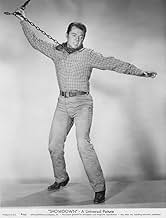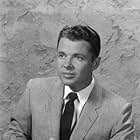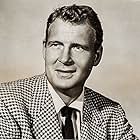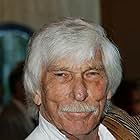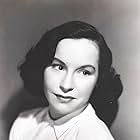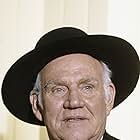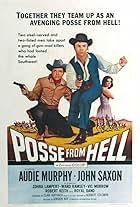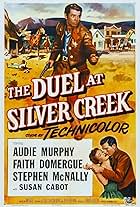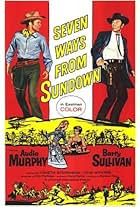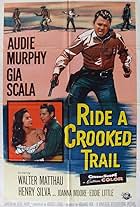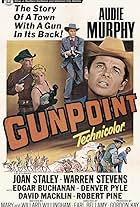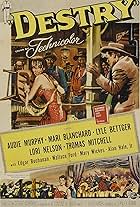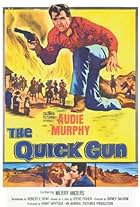A cowboy has to get 12,000 dollars in stolen bonds from the ex-girlfriend of his partner, or the gang holding him hostage will kill him.A cowboy has to get 12,000 dollars in stolen bonds from the ex-girlfriend of his partner, or the gang holding him hostage will kill him.A cowboy has to get 12,000 dollars in stolen bonds from the ex-girlfriend of his partner, or the gang holding him hostage will kill him.
E.J. André
- Station Master
- (uncredited)
Gordon Armitage
- Townsman
- (uncredited)
Eumenio Blanco
- Townsman
- (uncredited)
Bill Coontz
- Townsman
- (uncredited)
- Director
- Writer
- All cast & crew
- Production, box office & more at IMDbPro
Storyline
Did you know
- TriviaProducer Gordon Kay shot the film in black and white, to save money, which infuriated Murphy but the movie earned about the same as other Murphy films of the era.
- GoofsLeft behind when a gang steal saddleless horses Chris and Burt make their getaway on the two remaining horses and later while taking a breather are found by two of the gang who take them to a small ranch where the rest of the gang are hiding. The following morning when every on leaves all the horses are saddled.
- ConnectionsFeatured in The Great Train Robbery: A Copper's Tale (2013)
Featured review
SHOWDOWN (1963) has extensive location shooting around Lone Pine, California at the foot of the Sierras. Because it was shot in black-and-white, however, ostensibly to save money, the picturesque locations are not seen to their best advantage the way they are in Murphy's color westerns from that era (e.g. HELL BENT FOR LEATHER and SEVEN WAYS FROM SUNDOWN, both 1960). Color cinematography would have given us something interesting to look at during the labored proceedings. It's a low-budget affair with a contrived script provided by "Bronson Howitzer," a curious pseudonym for Ric Hardman, a writer of TV westerns. The plot is one of those routine potboilers about a group of outlaws holding the hero and various people hostage in hopes of a big payoff. At too many points in the script, people engage in uncharacteristic behavior in order to keep the basic situation intact. Two innocent cowboys, Chris (Audie Murphy) and Bert (Charles Drake), are detained after a drunken saloon fight and chained to an outdoor post alongside desperate outlaws in a town that doesn't have a jail. When the outlaws break free, the two friends inexplicably flee instead of staying and trying to explain their situation. Bert (Charles Drake) even steals some banknotes, which he then uses to bargain for his and Chris's life after the outlaws grab them. Each subsequent chain of events arises from the outlaw boss (Harold J. Stone) letting one friend or the other go off on his own on a mission involving the money, even though no self-respecting gang leader would place such trust in his hostages or let them go off on their own so easily. These outlaws are neither very tough nor very smart.
Things get more complicated when Bert's purported girl, a saloon singer named Estelle, enters the picture. She has a couple of dramatic scenes, including an extended monologue, that must have made the actress (Kathleen Crowley) quite happy but tend to slow the movie down. Only when Chris is on his own against the remaining gang members in rugged terrain does the picture get interesting. Unfortunately, there are not enough of these scenes to save the movie. Murphy's very good in a patented role as a decent ordinary guy caught up in the machinations of lawbreakers, but he would have been better in color and with a more thought-out script. There's a sense here that the production was just a bit on the hurried side.
Strother Martin plays a town drunk and L.Q. Jones plays a silent member of the gang. Both are among the town's prisoners chained to the same post early in the film. They're seen in shots together but don't interact. These two actors would make a memorable team six years later as the squabbling "gutter trash" bounty hunters Coffer and T.C. in Sam Peckinpah's THE WILD BUNCH.
According to "No Name on the Bullet: A Biography of Audie Murphy," by Don Graham, Murphy was quite upset when he learned that SHOWDOWN was being filmed in black-and-white and almost stopped working. "I'm not gonna act," is how he put it. The producer eventually talked him into finishing the movie, but Murphy vowed, "This is the last picture I'm gonna do in black and white." It was.
(Regarding the filming of Lone Pine locations cited in the first paragraph, I should stress that those landscapes can look absolutely breathtaking in black-and-white when captured by a master cinematographer. Just look at classic movies like LIVES OF A BENGAL LANCER (1935), CHARGE OF THE LIGHT BRIGADE (1936) and HIGH SIERRA (1941), to name three. But we're simply not going to see images like that in the kind of rush job we get in SHOWDOWN.)
Things get more complicated when Bert's purported girl, a saloon singer named Estelle, enters the picture. She has a couple of dramatic scenes, including an extended monologue, that must have made the actress (Kathleen Crowley) quite happy but tend to slow the movie down. Only when Chris is on his own against the remaining gang members in rugged terrain does the picture get interesting. Unfortunately, there are not enough of these scenes to save the movie. Murphy's very good in a patented role as a decent ordinary guy caught up in the machinations of lawbreakers, but he would have been better in color and with a more thought-out script. There's a sense here that the production was just a bit on the hurried side.
Strother Martin plays a town drunk and L.Q. Jones plays a silent member of the gang. Both are among the town's prisoners chained to the same post early in the film. They're seen in shots together but don't interact. These two actors would make a memorable team six years later as the squabbling "gutter trash" bounty hunters Coffer and T.C. in Sam Peckinpah's THE WILD BUNCH.
According to "No Name on the Bullet: A Biography of Audie Murphy," by Don Graham, Murphy was quite upset when he learned that SHOWDOWN was being filmed in black-and-white and almost stopped working. "I'm not gonna act," is how he put it. The producer eventually talked him into finishing the movie, but Murphy vowed, "This is the last picture I'm gonna do in black and white." It was.
(Regarding the filming of Lone Pine locations cited in the first paragraph, I should stress that those landscapes can look absolutely breathtaking in black-and-white when captured by a master cinematographer. Just look at classic movies like LIVES OF A BENGAL LANCER (1935), CHARGE OF THE LIGHT BRIGADE (1936) and HIGH SIERRA (1941), to name three. But we're simply not going to see images like that in the kind of rush job we get in SHOWDOWN.)
- BrianDanaCamp
- Mar 16, 2012
- Permalink
- How long is Showdown?Powered by Alexa
Details
Box office
- Budget
- $500,000 (estimated)
- Runtime1 hour 19 minutes
- Color
- Aspect ratio
- 1.37 : 1
Contribute to this page
Suggest an edit or add missing content




